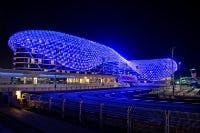In addition, one aspect of DMX512-A allows Remote Device Management (RDM), which enables, for instance, the setting of a DMX address remotely. That means that if you have a room full of pre-programmed lighting fixtures and one fixture is not behaving properly (flickering or showing the wrong light), as a user you can identify that fixture in your control layout without having to search for and source the wiring in the ceiling.
Butler highlighted other functionality that this new standard has brought to users. For instance, remote sensing of temperature inside a luminaire can be performed, a feature that came in particularly handy when Traxon was involved in the lighting installation in Abu Dhabi at the YAS Hotel. “In the Middle East, temperature monitoring of the outside LED lights was particularly important, and we ensured that the each light remained within an acceptable temperature range using RDM,” Butler said. Touted as the world’s largest LED installation in 2010, the RDM system allows bidirectional communication between the LED lights in the façade and the control server.
Another technology employed in such large installations according to Butler is the transfer of DMX protocol data from the server to Ethernet-based cable that is then sent out to multiple client-based servers where it is again converted to DMX data. “The reason for doing this is because Ethernet hardware speeds the transfer of the data across these distances,” Butler explained.
Such hardware changes are allowing users to customize media façades and quickly change between not only pre-programmed sequences but also interactive video, third-party-supplied streaming video or even live video using a photographer. As Butler commented, such developments are allowing façades to be more dynamic than ever.






